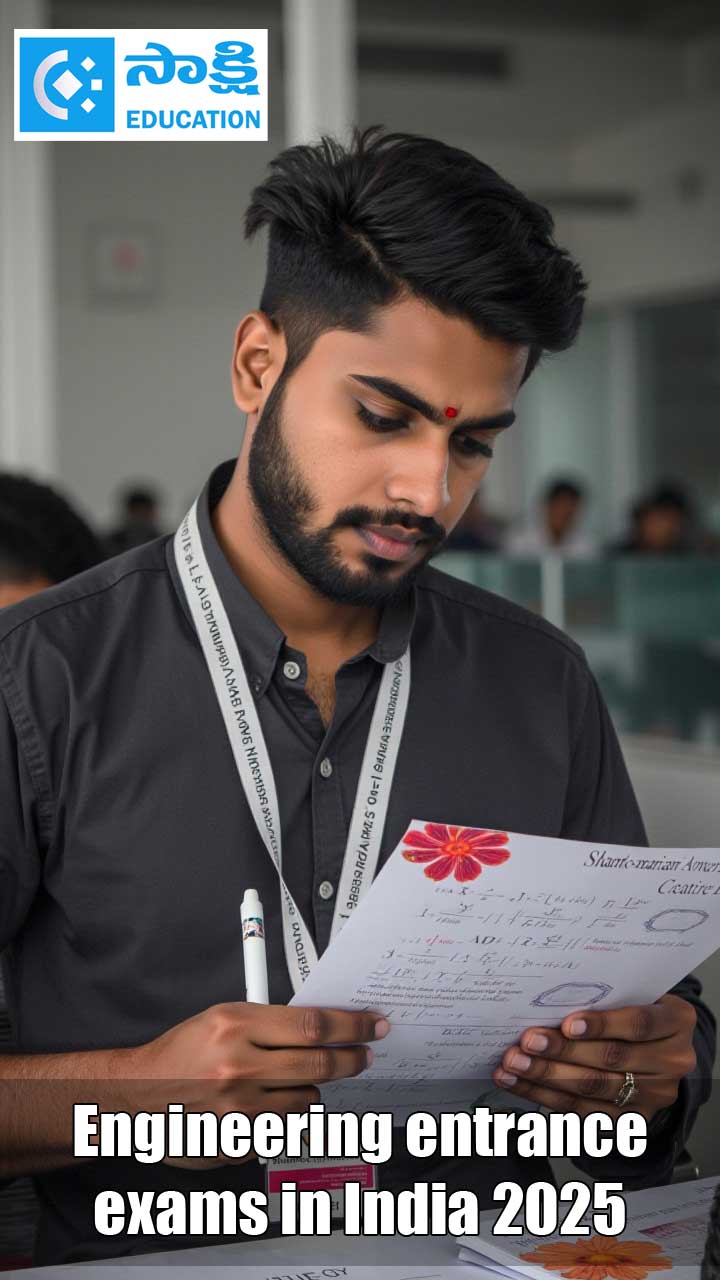A Good Project enhances your opportunities for the Job or Higher Education: Principal, ANU College of Engineering
Sakshi Education

Implementing practically what we learn is more important for an engineer. What students learn from last three years is the foundation of the project. Some of the companies will absorb the students who will do good project work. In the final year second semester students must do a live project for about six months but are neglecting in doing a good project and spending most of their time in taking coaching for campus placements. Doing a good project in core area will enhance your basic knowledge in that domain. This will indirectly boost up your success rate in campus recruitments. There are many agencies today to fund your project if it is innovative and helpful for society.
Live project
Live project means you must find out solution for any one of the current problem in your field of engineering. In this heavy competition, it is very difficult to get a good live project in companies. Even though if it is not possible, try to understand the basics perfectly, select any one of the core subject and implement any one of the concept that you are good at in that subject, then it will become a good project. If possible, down load IEEE papers in your interested area and try to implement them one can do a good project. By implementing basic concepts in any field of interest, one could get hold on subject.
Selecting a topic for the Project
For selection of any topic, it is very essential to provide a clear description of the subject or thesis report, which you want to convey to your advisor. Selecting a topic which is interesting and which is catchy to you will be a right choice. Your topic must be a subject having a large scope in it. The topic having no further scope makes the person disheartened. You must think a lot on topic which you are going to choose and must try doing your best in your work to get excellent results.
If students have real thrust to do an innovative project in current technology, it is better to handle any one of the IEEE research paper in the domain of his interest. Initially it is difficult to understand an IEEE paper for an under graduate student but once he understands and is capable to implement the method proposed in the paper, he can reach easily greater heights in future for higher studies.
Different ways of selecting a project;
First:
Live project
Live project means you must find out solution for any one of the current problem in your field of engineering. In this heavy competition, it is very difficult to get a good live project in companies. Even though if it is not possible, try to understand the basics perfectly, select any one of the core subject and implement any one of the concept that you are good at in that subject, then it will become a good project. If possible, down load IEEE papers in your interested area and try to implement them one can do a good project. By implementing basic concepts in any field of interest, one could get hold on subject.
Selecting a topic for the Project
For selection of any topic, it is very essential to provide a clear description of the subject or thesis report, which you want to convey to your advisor. Selecting a topic which is interesting and which is catchy to you will be a right choice. Your topic must be a subject having a large scope in it. The topic having no further scope makes the person disheartened. You must think a lot on topic which you are going to choose and must try doing your best in your work to get excellent results.
If students have real thrust to do an innovative project in current technology, it is better to handle any one of the IEEE research paper in the domain of his interest. Initially it is difficult to understand an IEEE paper for an under graduate student but once he understands and is capable to implement the method proposed in the paper, he can reach easily greater heights in future for higher studies.
Different ways of selecting a project;
First:
- Find out the core area of your interest.
- Learn about current trends in that area
- Down load recent research papers on these topics.
- Try to understand at least one paper and implement it
- Find out the core area of your interest
- Learn about the applications of that area.
- Take any one of the application and study about it.
- Find the pit falls in it and try to rectify.
- Title page
- Certificate
- Abstract or Synopsis
- Acknowledgments
- Table of Contents l
- List of table & figures (optional)
- Chapter 1(Introduction)
- Chapter 2( Literature Review)
- Chapter 3 ( Design Methodology)
- Chapter 4(Results & Discussion)
- References
- Annexure (optional)
- An abstract (synopsis) not exceeding 100 words, indicating salient features of the work. (NB: four copies of the abstract are to be submitted to the Department on the date of submission separately)
- Chapters (to be numbered in Arabic) containing Introduction-, which usually specifies the scope of work and its importance and relation to previous work and the present developments, Main body of the report divided appropriately into chapters, sections and subsections.
- The chapters, sections and subsections may be numbered in the decimal form for e.g. Chapter 2, sections as 2.1, 2.2 etc., and subsections as 2.2.3, 2.5.1 etc.
- The chapter must be left or right justified (font size 16). Followed by the title of chapter centered (font size 18), section/subsection numbers along with their headings must be left justified with section number and its heading in font size 16 and subsection and its heading in font size 14. The body or the text of the report should have font size 12.
- The figures and tables must be numbered chapter wise for e.g.: Fig. 2.1 Block diagram of a serial binary adder, Table 3.1 Primitive flow table, etc.
- The last chapter should contain the summary of the work carried, contributions if any, their utility along with the scope for further work.
- For textbooks - A.V. Oppenheim and R.W. Schafer, Digital Signal Processing, Englewood, N.J., Prentice Hall, 3 Edition, 1975.
- For papers - David, Insulation design to combat pollution problem, Proc of IEEE, PAS, Vol 71, Aug 1981, pp 1901-1907.
- Only SI units are to be used in the report. Important equations must be numbered in decimal form for e.g.
V = IZ .......... (3.2) - All equation numbers should be right justified.
- The project report should be brief and include descriptions of work carried out by others only to the minimum extent necessary. Verbatim reproduction of material available elsewhere should be strictly avoided. Where short excerpts from published work are desired to be included, they should be within quotation marks appropriately referenced.
- Proper attention is to be paid not only to the technical contents but also to the organization of the report and clarity of the expression. Due care should be taken to avoid spelling and typing errors. The student should note that report-write-up forms the important component in the overall evaluation of the project
- Hardware projects must include: the component layout, complete circuit with the component list containing the name of the component, numbers used, etc. and the main component data sheets as Appendix. At the time of report submissions, the students must hand over a copy of these details to the project coordinator and see that they are entered in proper registers maintained in the department.
- Software projects must include a virus free disc, containing the software developed by them along with the read me file. Read me file should contain the details of the variables used, salient features of the software and procedure of using them: compiling procedure, details of the computer hardware/software requirements to run the same, etc. If the developed software uses any public domain software downloaded from some site, then the address of the site along with the module name etc. must be included on a separate sheet. It must be properly acknowledged in the acknowledgments.
- Sponsored Projects must also satisfy the above requirements along with statement of accounts, bills for the same dully attested by the concerned guides to process further, They must also produce NOC from the concerned guide before taking the internal viva examination.
- The reports submitted to the department/guide(s) must be hard bounded, with a plastic covering.
- Separator sheets, used if any, between chapters, should be of thin paper
- Project reports should be typed neatly only on one side of the paper with 1.5 or double line spacing on a A4 size bond paper (210 x 297 mm). The margins should be: Left - 1.25", Right - 1", Top and Bottom - 0.75".
Execution of the project work effectively
Another important aspect is execution of the project work. Most of the students will start a project but they don’t spend much time in doing the project.
Steps for execution of project work
Another important aspect is execution of the project work. Most of the students will start a project but they don’t spend much time in doing the project.
Steps for execution of project work
- Maintain a daily record showing your work progress. Get it signed by your mentor.
- Normally 4 months duration will be there for doing undergraduate project. Out of four months, spend one month completely for studying relevant projects or understand the problem, which you have taken.
- Implement the project for 2 months and test your project for one month.
- Normally 2 or 3 interim seminars must be given to show your project progress.
Final word for students
Students who are going for higher education such as M.S. or M.Tech, project work plays a vital role. If you neglect at under graduate level, then it is very difficult to practice in post graduation. Also doing a good project in particular area, it will lead to do post graduation in that area of specialization. Better understanding the domain will improve your knowledge levels.
Do’s and Don’ts for project work:
Donts:
Students who are going for higher education such as M.S. or M.Tech, project work plays a vital role. If you neglect at under graduate level, then it is very difficult to practice in post graduation. Also doing a good project in particular area, it will lead to do post graduation in that area of specialization. Better understanding the domain will improve your knowledge levels.
Do’s and Don’ts for project work:
Donts:
- Don’t try to purchase fake projects.
- Don’t copy previous projects
- Don’t be large group for doing project. Limit it for 2 or 3 members.
- Don’t through burden of doing project on one person. Share the work and do your part sincerely.
- Don’t waste the project time in other activities.
- Don’t try to get marks, try to get knowledge from the project.
- Maintain a record showing day-to-day progress without fail.
- Collect adequate previous papers and works in the relevant area, which will become references.
- Save your results and algorithms that will be useful in future.
- Compare your results with other techniques.
Principal,
University College of Engineering, ANU
Published date : 29 Jan 2013 07:03PM



















